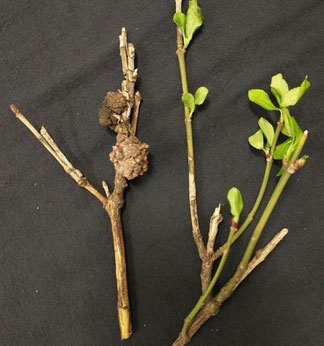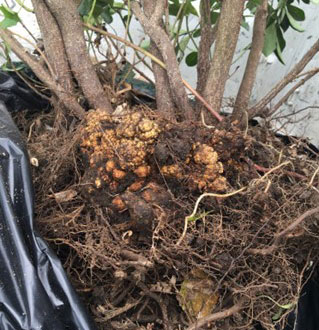Euonymus Crown Gall
Contact
Plant Diagnostician
Phone: (479) 575-2727
Email: ssmith@uada.edu
Jason Pavel
Diagnostician
Phone: (479) 575-7257
Email: jpavel@uada.edu
University of Arkansas System Division of Agriculture
Cralley Warren Building
Room 16
2601 N. Young Ave.
Fayetteville, AR 72704
Euonymus Crown Gall
Sherrie Smith and Jason Pavel
Plant Health Clinic Disease Note Issue 10

Euonymus Crown Gall- Agrobacterium tumefaciens. (Photo by Jason Pavel, University of Arkansas System Cooperative Extension Service)
Crown gall is a serious disease of roots, stems, and crowns on a wide range of plants. Some of the most common hosts are apples grapes, plums, roses, blackberries, raspberries, muscadines, hollies, euonymus, and numerous other trees and shrubs.
What causes euonymus crown gall?
Crown gall is caused by the bacterium Agrobacterium tumefaciens. The bacteria enter through wounds made by animals, insects, grafting, pruning, transplanting, and cultivation tools.
How can I identify euonymus crown gall?
Rough, knobby galls develop on the crown at the soil line. Lateral roots and support roots may also develop galls. Some aerial galls may develop on heavily infected plants.
Newly formed galls are light tan-colored and soft. Older galls become hard, woody, and dark brown to black. Galls vary in size from a few inches to more than a foot across.
How does euonymus crown gall affect my plant?

A few small galls do not seriously impact the plant. However, large numbers of galls can cause stunting, chlorosis, and eventual plant death. Infected plants in orchards and landscapes should be pulled up and destroyed.
How do I prevent euonymus crown gall?
Care should be taken to avoid injury to plants when mowing or weed eating around them.
Growing non-susceptible crops such as grasses for three years will nearly eliminate
the bacterium from the soil. Dipping the roots of new plants before planting in a
product called Galltrol helps prevent infection. However, it is not currently labeled
in Arkansas.
Take Aways:
- Avoid mechanical injury to plants.
- Grow non -susceptible grasses for 3 years.
- Remove all parts of infected plants.
Follow us on Facebook!
UAEX Plant Health Clinic
This work is supported by the Crop Protection and Pest Management Program [grant no. 2017-70006- 27279/project accession no. 1013890] from the USDA National Institute of Food and Agriculture.